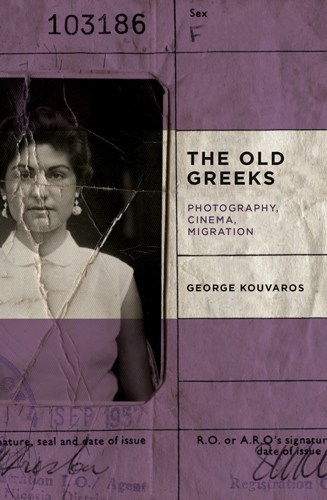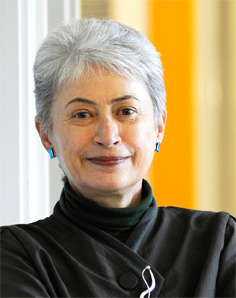Still (and) Moving Images: The Old Greeks: Photography, Cinema, Migration
This is an origin story of sorts, but like all such tales it is enveloped in enigma. We are prompted to ask whose origins and to speculate about the degree to which an individual identifies with aspects of a group or groups: Australia? Greek Australian? Cypriot Greek? The title initially evokes the Hellenistic archive of eloquent myths and narratives that underpin a European culture permeated by a sense of its universalist entitlements. But Kouvaros’s study actually scrutinises many of these assumptions and the ‘old Greeks’ of his title comprise his family members and the larger and complexly affiliated Greek diaspora that accumulated in Australia around the middle of the twentieth century:
This is where I want to begin the story of migration told in this book: in connection to those encounters that evoke a delicate balance between survival and extinction, expectation and obligation, onlooker and image.
Those of us who laboured to raise awareness in the Australian context of these other histories, languages and individuals in the 1980s and beyond have been waiting for such elegant and moving analyses. Kouvaros’s study is evidence for the rich yields that such archives contain so long as they survive institutional neglect and landfills.
Kouvaros is the author of numerous studies of American cinema and cinematographers (Robert Frank, Paul Schrader, John Cassavetes), but here he brings his scholarly expertise to bear on the archive presented by his own family’s migration from Cyprus to Australia and on how this in turn relates to the Greek-Australian diaspora. Beginning with his mother’s creased identity card from the era when Cyprus was colonised by the British Kouvaros links the great themes of twentieth-century migration to the affective structures provided by both photography and cinema that give a purchase for those lost and uprooted individuals swept up in these global eddies. His relatively short and multi-faceted meditation provides an analytical scaffold as well as a moving response to his own question—what do we owe our ancestors and the dead?
Not least of his achievements is that Kouvaros offers strong evidence for the ways in which those non-Anglo-Celtic Australians are intertwined with and make claims on Australian and global modernities. Using photography and cinema to provide a framework for international modernism, Kouvaros invokes the familiar reference points such as Barthes and Berger for photography; Kracauer and Calvino for cinema; Proust for memory; Naipaul and Said for exile and links them meaningfully and generatively to the Greek diaspora’s own reference points of Cavafy and Seferis, as well as the films of Theo Angelopouos. In addition he situates Greek Australian artists such as Elizabeth Gertsakis, Anna Kannava and John Conomos within these legacies. Kouvaros demonstrates that those ‘old Greeks’ who undertook the original difficult migrations to Australia in the twentieth century were implicated in modernity and not simply confined to some primitive atavistic past, with no relevance to contemporaneity. Indeed, when rescued from oblivion, as in this study, they continue to interrogate received notions of a (European) universalistic modernity that prevails largely only in its British manifestations in Australian cultural debates.
The photographs that accompany migration are an inherently static medium, as distinct from the mobility that is associated with migration itself. A different mobility is resumed in the relationship of interpretation that occurs between the viewer and the photo that animates the latter with both a personal and social contextualising history.
Kouvaros begins with that most everyday object, the family photo, often taken to memorialise the moment of departure. While these have now often been translated into and superseded by digital versions, the question remains for many of us of what to do with these very specific artifacts. In some traditions they are employed eventually to adorn a headstone, but in others they are secreted in drawers or in dusty, rarely perused albums – or end up in landfills. Kouvaros subjects them to prolonged and serious scrutiny so that something inherently passive becomes dynamic, knitting together space and time in unexpected ways. But this work also raises the question of how one constitutes the archive: what does one choose to include? Letters, for example, are mentioned but not subject to the same close appraisal.
The photographs become evidence of an array of alternative histories that would punctuate Australian history and change its normative contours entirely if these groups were ever adequately researched and represented. (Certainly there is more research happening than there was several decades ago but it does not necessarily accompany an awareness of ensuring that relevant institutions both promote this research and ensure that archives are collected and maintained.) The context of British colonialism in Cyprus situates Kouvaros’s mother’s identity card and suggests in turn the violent upheavals within Cyprus that followed the departure of the British.
Another affective history concerns a parental generation exhausted by working several jobs in order to keep families going. The unexpected consequence of this was that the parents compromised their own children’s passageways to the modernities inflected by Americanisation that erupted in Australia in the 1960s. The uncaptioned photo of the author in his family’s milk bar in Newcastle speaks volumes in terms of resentment and frustration but also invokes the legacy of a kind of guilt or unspoken contract that infuses Kouvaros’s scholarly life and career. Many of us who are children of migrants or arrived as children recognise this burden. At the same time that this generation achieved a class mobility that often alienated them from their parents’ worlds there remained a few tethers (e.g. funerals) that at least provided threads to lead them back to those histories when they were ready to receive them. And this is what Kouvaros does by linking his own preoccupations and scholarly expertise in photography and cinema to the everyday realities of his parents’ generation.
As Kouvaros points out, cinema provided an aspirational visuality or grammar of the visual for those postwar individuals moving from villages into a wider engagement with globality. For example, the cinema his parents encountered were a mix of the Hollywood global machine (A Place in the Sun) as well as the local cinema (such as the films of Angelopolous) they may have encountered after migration. In the case of the Greek diaspora, the numbers were large enough provide a communal hunger for these manifestations of ‘home’ to be screened in local venues. For other groups it was more difficult to access these founts of a different reality, before the technological advent of the internet and YouTube.
Kouvaros analyses the dimensions of these cinematic exemplars and links them in turn to the evocative work of local artists such as Elizabeth Gertsakis’s important installation Innocent Reading for Origin where the mysterious photos from a family history are framed with the appropriately inappropriate questions voiced by a child who only ‘half understands’ that history, not even knowing the right questions to ask:
In a deceptively simple manner, Gertsakis’s work establishes a series of affinities between photography, a vision of history as unknowable, and an experience of migration marked by the failure of things to carry over and survive the uprooting. The outcome is a dizzying sense of contingency: Why am I here rather than there? Why am I alive now rather than then?
Ultimately Gertsakis’s work generates the following idea about one’s ancestors: ‘They imbue the present with a sense of generational obligation: How to speak well of the dead?’ The dead in this instance have been largely written out of mainstream Australian history and this process of retrieval is a laborious and necessary one.
The late Cypriot Australian filmmaker Anna Kannava frames her themes by using Proust’s point that in the nineteenth-century world his memoirs evoked, the visiting photographer is an alien intruder whose technological mediation represents his subject in terms of a demeaning realism (an aging grandmother) that diminishes the ways in which family members are tied into and are an idealized part of our sensibilities. Contemplating Kannava’s unusual methods of staging her memories and her narrating voice-overs, Kouvaros sees her films as presenting the stark sense of ‘belatedness’ that the returning migrant always encounters. As well,
the filmmaker uses actors to dramatise events and experiences from her past. The purpose of these dramatisations is to recount how the experience of migration was negotiated at the time … to show us the games and rituals devised by the director and her siblings to combat their sense of isolation. The touchstone for these activities were the Greek melodramas screened at the Astor cinema in Saint Kilda on the two evenings a week when the filmmaker’s mother worked in the box office.
Such ephemera of the everyday are rescued by both Kannava and Kouvaros.
While the study is framed by the mother’s story and her ambivalent oscillation between migration and settlement, chapter 7, which deals with the work of the multimedia artist John Conomos, introduces the concept of ‘father-hunger’ as a way of dealing with both the hyper-visibility and absence of migrant fathers. Kouvaros’s father is exhausted through working at two jobs to sustain the family and is not able to do much parenting, which is ultimately left to the mother. In Conomos’s work he finds a counter-discourse on cinema that fuels its ‘phantasmatic force – its ability to give life to images that form our history and spirit it away’ an assertion that is echoed later in relation to Truffaut’s film The 400 Blows. As Kouvaros states,
Conomos’s account of the long hours in the milk bar when he would gaze out at the world on the other side of the glass doors, of the feeling of father-hunger and the influence of people and places barely grasped, models a history of migration that employs images and sounds to bring something out of the darkness.
The implication is that this process is never completely successful in that it replaces the family detritus of random photographs with a deceptively coherent regime of visuality that never quite banishes the unhealable wound left by migration.
At the end of the book Kouvaros gives the last word, again, to the (implicit) mother-son dialogue that opened the book and suggests that one need not inevitably choose either here or there, since his mother throughout her life had remained loyal to both places. If circumstances allow, this is one model although for many who are part of recent refugee groups brutally displaced it is not an option. And certainly the return journey is easier now, materially speaking, than it was in the immediate postwar period. That ability to return changes the nature of immigration as a psychological quandary, but as this study frequently points out, returns are inevitably accompanied by a notion of belatedness.
While Kouvaros is very clear about the preoccupations that frame his study, what is missing (at least to this reviewer) is the engagement with writing and the literary. As mentioned earlier, family photographs are often flanked by family letters. While Kouvaros does refer to authors who have mined the complexities of exile such as Edward Said and V. S. Naipaul, he does not then make the further link to the Australian writers who could easily have provided further robust material for his study. While oral narrative has a place in the book, and his maternal grandmother provides an unforgettable example, he says he never saw her reading and recalls no books in her house. So the rich multilingual legacy of writing from Greek Australians and other non-Anglo-Celtic Australians analysing this legacy is not touched upon or mentioned as a significant absence. Certainly it is the case that this wonderful study itself adds to that written legacy.






